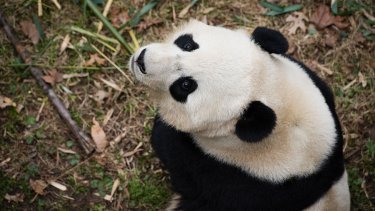Washington, D.C
New DC panda Bao Li's mom was a star at the National Zoo, too

The Panda Express has landed! A specially outfitted FedEx plane landed Tuesday morning at Dulles International Airport with some VIP passengers: a pair of 3-year-old pandas who will take up residence at the Smithsonian’s National Zoo.
Bao Li and Qing Bao were born in China. Although the surroundings will be new for both of them, Bao Li’s D.C. roots go deep: He’s a third-generation Washingtonian!
His grandparents, Mei Xiang and Tian Tian, lived at the National Zoo for nearly a quarter-century and welcomed the zoo’s first-ever surviving panda cubs. The first, Tai Shan, arrived in 2005, but years went by before another was born, and that cub lived for just a week.
The following year, in 2013, a squirming newborn arrived, along with a stillborn twin. But as D.C. held its collective breath, the living cub thrived.
At 100 days old, she was named Bao Bao, and she provided plenty of adorable entertainment for panda fans.
She squawked loudly during vet exams captured on video. (Make sure your volume is up for this one.)
She tumbled (safely — whew!) down a pile of rocks, with her nervous mom hurrying to check on her after the spill.
And she even prolonged the excitement when the National Zoo’s webcam went dark during a government shutdown. When the cams went live again, she had a new surprise: Her eyes had opened.
Maybe it was just us, but Bao Bao always seemed to know when to drum up some attention. She was the source of some adorable headlines. (Case in point: Mei Xiang Cuddles Cub Rather Than Snacking.)
There was a paternity drama — was her biological father the zoo’s own Tian Tian, or another male panda whose sperm was also used in a fertility attempt? (Verdict: Tian Tian IS the father.)
Paul J. Richards/AFP via Getty Images
And just before Christmas 2014, Bao Bao spent 24 hours in a tree, diverting focus from holiday celebrations before she finally climbed down.
But after becoming a big sister, Bao Bao was ready to strike out on her own.
Sarah L. Voisin/The Washington Post via Getty Images
She moved to China in 2017 and became a mom, including to a set of twins born there in 2021. One of those twins was Bao Li. Now, he’s made the journey for himself.
However, the public will have to wait a bit longer to visit the zoo’s newest residents.
Bao Li and Qing Bao are expected to be quarantined for at least 30 days, and they’ll also need time to get settled in and acclimated to their new surroundings before the panda exhibit reopens to the public. There’s no exact date set yet for that.

Washington, D.C
New bus service to begin soon between Hampton Roads and Washington, D.C.

The United States military carried out a “large scale” strike inside the nation of Venezuela early Saturday morning, in addition to capturing Venezuelan President Nicolas Maduro and his wife, who were flown out of the country.
https://www.wavy.com/news/national/virginia-leaders-speak-out-after-u-s-military-strike-on-venezuela/
Washington, D.C
No one hurt in Northwest DC row house fire

WASHINGTON (DC News Now) — Smoke was seen billowing in a Northwest D.C. neighborhood Sunday afternoon after a row house caught fire, prompting a large presence of first responders.
In a post on the X platform just after 12:40 p.m., the DC Fire and EMS Department said crews were responding to a box alarm at a row house in the 2100 block of 13th Street NW. There, firefighters found smoke coming from the top of three attached row houses.
Crews determined that the flames were coming from the attic of one of the three-story row homes, but that it was at risk of spreading to both adjacent homes. As a result, firefighters upgraded the response to a two-alarm fire, aggressively attacking the flames from the inside.
Officials noted that firefighters were able to extinguish the blaze, which involved the entire attic, and that it only spread to one of the attached row houses.
No injuries were reported; however, officials were working to learn how many people would be displaced.
The cause of the fire remains under investigation.
Washington, D.C
What’s the best meal Keith Duggan can get for €120 in Washington?

Every day this week, our foreign correspondents will accept the challenge of finding the best meal possible in their city for the equivalent of €120. First, Keith Duggan introduces us to dinner in a Washington bookshop.
You won’t live the high life in Washington, DC on a dining budget of €120, but nor will you starve.
The return of Donald Trump in January this year coincided with a prolonged winter blast of snow and the sense of an entirely new era in the city.
Within weeks, Butterworth’s, on Capitol Hill, began appearing in news and magazine articles as a popular meeting spot among the ascendant Maga set – it was the restaurant of choice for Steve Bannon when he participated in the “Lunch with the FT” feature, cheerfully assuring readers that Trump would run for a third term.
Aside from attracting Maga-ites it has drawn rave reviews for an unfussy reimagining of standard bistro favourites and terrific staff. They’ll happily let you in the door in Butterworth’s with your modest budget. But it won’t take them long to serve you.
You could book an evening dinner table, split the crispy cauliflower with miso caramel ($18), have mains of dry-aged duck breast with kale and sauce verjus ($37) or lamb heart Bolognese ($29, and a Maga fave, one imagines), definitely forsake the cocktail menu and have a couple of glasses of Sancerre – and still leave a standard tip of at least 20 per cent.
But a better option, on this budget, would be to take yourself off to one of Washington’s venerable old haunts, Kramers. It’s essentially a wonderful independent bookshop masquerading as both a bar and cafe/restaurant that has been a fixture on Connecticut Avenue, just above the famous green and water fountain on Dupont Circle, since the 1940s.
It was where the concept of the bookshop cafe originated in the United States and for a time, in the boozier decades, it remained open all night.
Now, like much of Washington, the shutters come down early.
Celebrated past visitors include Maya Angelou and Barack Obama, but the place hit national headlines in 1998 when the owner, Bill Kramer, fought a court petition from independent counsel Kenneth Starr to have the bookshop reveal the titles of the books bought by one of its customers, Monica Lewinsky.
[ Patrick Freyne’s quest for the best Christmas sandwich in Dublin: ‘I give it five Santas out of five’Opens in new window ]
It’s a hugely popular weekend brunch location, particularly when it’s still warm enough to sit outside. Unsuspecting first-time visitors often move from the poetry section through a narrow doorway and in to the darkened bar, mirroring the pathway of many an actual poet. The bar is low-lit, even during the day. The restaurant is at the rear.
Decor is minimalist, to put it politely, but the menu is eclectic and everything is good. Steak and eggs ($29) and Kramers Benedict ($22) are brunch staples. For dinner, the cream of crab soup ($14) is served with grilled ciabatta and the crispy Brussels sprouts ($12), with lemon, parmesan and a side of ranch dressing, do much to rehab the reputation of that maligned veg.
Pizzas and those ginormous American sandwiches also feature, but highlights on the mains are blackened salmon ($25) and the shrimp and grits with Andouille sausage in a spicy tomato sauce ($22). It’s the sort of place that invites parking of calorific anxieties at the door.
The Triple Chocolate Devil’s Food Cake ($12) is the best reason to visit Kramers, and possibly Washington itself. It’s an obscenity, in the best sense.
The wine list is short and modestly priced: a bottle of the (only) Sauvignon Blanc is $35. So that’s a three-course meal for two for $120 (if you skip the caffeine) – a bill which would suggest a tip of around $30. And you might even pick up a book. kramers.com
-

 Entertainment1 week ago
Entertainment1 week agoHow the Grinch went from a Yuletide bit player to a Christmas A-lister
-

 Connecticut1 week ago
Connecticut1 week agoSnow Accumulation Estimates Increase For CT: Here Are The County-By-County Projections
-

 World6 days ago
World6 days agoHamas builds new terror regime in Gaza, recruiting teens amid problematic election
-

 Indianapolis, IN1 week ago
Indianapolis, IN1 week agoIndianapolis Colts playoffs: Updated elimination scenario, AFC standings, playoff picture for Week 17
-

 Southeast1 week ago
Southeast1 week agoTwo attorneys vanish during Florida fishing trip as ‘heartbroken’ wife pleads for help finding them
-

 World1 week ago
World1 week agoSnoop Dogg, Lainey Wilson, Huntr/x and Andrea Bocelli Deliver Christmas-Themed Halftime Show for Netflix’s NFL Lions-Vikings Telecast
-

 World1 week ago
World1 week agoBest of 2025: Top five defining moments in the European Parliament
-

 Business1 week ago
Business1 week agoGoogle is at last letting users swap out embarrassing Gmail addresses without losing their data


























